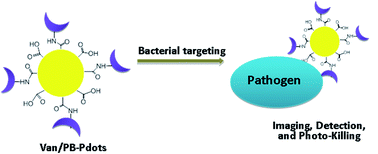Multifunctional semiconducting polymer dots for imaging, detection, and photo-killing of bacteria†
Abstract
Bacterial infections remain a key challenge in medicine and environment safety. Motivated by current clinical requirements, numerous diagnostic and therapeutic nanomaterials have emerged. Here, a family of agents, termed as antibiotic-based multifunctional semiconducting polymer dots (Pdots), which can detect bacteria with high sensitivity and selectively kill gram-positive bacteria or gram-negative bacteria, are reported. The multifunctional Pdots that exhibit good flexibility and stability at room temperature are usually small, and they can easily be modified to biomolecules. The highlight of this work is about how the developed bioconjugated Pdot system simultaneously possesses the abilities of detection, imaging, and pathogen photo-killing. This study not only demonstrates a facile approach to fabricate a bioconjugated probe for bacteria detection, but also provides a powerful and reliable platform for the photo-killing of pathogens, thus rendering potential broad antibacterial applications, bacteria diagnosis, and live-image assays.


 Please wait while we load your content...
Please wait while we load your content...